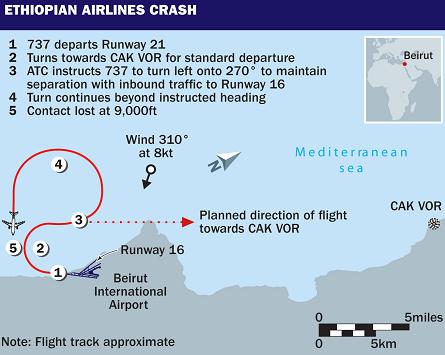Preliminary information about the final few minutes of yesterday's ill-fated Ethiopian Airlines flight out of Beirut indicates that the aircraft was struggling to comply with air traffic control instructions to change heading.
The Boeing 737-800, bound for Addis Ababa as flight ET409, departed towards the south from Beirut's runway 21 in darkness, but initial information suggests that the jet first turned right to head north, over the Mediterranean Sea, and was cleared to climb to a minimum crossing altitude to transit through Syrian airspace to the east.
An air traffic control source familiar with the event tells Air Transport Intelligence that an exchange with Beirut centre discussed navigating towards the VOR beacon identified as CAK, which lies on the Lebanese coast north of Beirut.
But he says that air traffic control needed to ensure separation between ET409 and two aircraft which were on approach to Beirut's runway 16 at the time.
In order to maintain separation, he says, ET409 was instructed to turn left onto a heading of 270° but the crew apparently failed to comply.
"Instead it turned left, further," says the source, adding that - as the heading wound down to 140° - controllers became alarmed that the aircraft was turning back towards land and high terrain.
|
|---|
© Tim Brown |
Meteorological data confirms the presence of thunderstorm activity but there is no immediate evidence that the conditions directly led to the loss of the aircraft.
Investigators have yet to retrieve either the cockpit-voice or flight-data recorder. The recovery effort has been hampered by poor weather.
But Ethiopian Airlines says that a specialised vessel is being brought in to assist, adding: "This, we believe, will facilitate an earlier recovery of the [flight recorders]. It will also help to find and lift the main fuselage of the aircraft. So far, part of the wreckage and some life rafts have been recovered from the area."
Ninety passengers and crew were on board the jet but rescue teams have not found any survivors.
Lead image © Air Team Images
David Learmount's blog: Another one in the sea at night
Source: Air Transport Intelligence news

















